Overview
Healthcare application development offers ten key benefits for SaaS owners, fundamentally transforming patient care, operational efficiency, and service accessibility. By enhancing communication, integrating telehealth capabilities, and leveraging data-driven insights, these applications not only improve health outcomes but also boost patient engagement. This positions SaaS providers to seize opportunities in the rapidly evolving healthcare landscape.
Consider the impact of enhanced communication. With streamlined channels, healthcare professionals can connect with patients more effectively, leading to timely interventions and improved satisfaction. Telehealth capabilities further expand access, allowing patients to receive care from the comfort of their homes, which is especially crucial in today’s fast-paced world.
Moreover, data-driven insights empower providers to make informed decisions, tailoring services to meet patient needs. This analytical approach not only enhances operational efficiency but also fosters a proactive healthcare environment, ultimately driving better health outcomes.
In conclusion, the development of healthcare applications is not just a trend; it’s a strategic move for SaaS owners looking to thrive in a competitive market. By embracing these advancements, you position your organization at the forefront of healthcare innovation. Don’t miss out on the chance to elevate your services and engage your patients like never before.
Introduction
The rapid evolution of healthcare technology offers SaaS owners a remarkable chance to transform patient care and service delivery. By leveraging healthcare application development, these innovators can craft solutions that not only boost operational efficiency but also significantly enhance patient outcomes. Yet, navigating the complexities of this dynamic landscape poses a challenge.
What compelling benefits can healthcare applications provide, and how can they be seamlessly integrated into existing systems? This article explores ten key advantages of healthcare application development, illuminating the path for SaaS providers eager to make a substantial impact in the medical field.
SDA: Custom Software Development for Enhanced Patient Care
SDA stands at the forefront of bespoke software solutions, revolutionizing care for individuals through advanced technologies tailored for the medical field. Our commitment to user-focused design and robust functionality ensures that medical software not only meets regulatory standards but also significantly enhances the overall experience for users. This dedication to quality and innovation positions SDA as a strategic ally for SaaS owners who aspire to make a profound impact in service delivery.
Imagine a world where healthcare application development enables medical software to seamlessly integrate into healthcare practices, improving outcomes and elevating patient experiences. With SDA, this vision becomes a reality. Our solutions are crafted with precision, ensuring compliance while prioritizing user engagement. By choosing SDA, you align with a partner that values excellence and innovation.
Join us in transforming healthcare delivery. Let SDA empower your SaaS offerings with cutting-edge healthcare application development solutions that truly make a difference.
Telehealth Applications: Convenient Access to Medical Services
Telehealth applications empower individuals to consult with medical professionals remotely, significantly reducing the necessity for in-person visits. This convenience not only saves valuable time for patients but also enables medical providers to reach a broader audience. By 2025, approximately 80% of people in the U.S. will have accessed telehealth services at least once, marking a substantial shift towards virtual healthcare.
Embracing telehealth solutions in healthcare application development presents SaaS owners with a prime opportunity to tap into a burgeoning market that prioritizes accessibility and efficiency in medical delivery. The benefits of telehealth extend beyond mere convenience; they include:
- Heightened satisfaction among patients
- Improved access to services for underserved populations
- The ability for providers to manage a larger patient load effectively
Moreover, healthcare experts have noted that telehealth can lead to better outcomes for patients by facilitating timely consultations and follow-ups. This ultimately transforms the care framework, making it more responsive and effective. Are you ready to be part of this healthcare revolution? The time to act is now.

Improved Communication: Enhanced Coordination Between Patients and Providers
Healthcare application development is essential for enhancing communication between individuals and providers, enabling real-time updates and feedback. Features like secure messaging and appointment reminders significantly improve coordination, ensuring individuals receive timely health information. For instance, Northwell Health's text-based chat service effectively monitors various groups, including those at high postpartum risk and individuals with chronic conditions such as diabetes and heart failure. This service provides regular health insights that lead to positive feedback and reduced hospital readmissions. Such proactive methods not only enhance engagement but also foster a supportive environment where individuals feel cared for, often likening chatbots to a daily check-in companion.
The integration of secure messaging profoundly impacts user satisfaction by facilitating prompt responses to inquiries and concerns. Medical communication experts emphasize that transparency regarding the use of individual information is crucial for building trust. This focus on secure, real-time communication ultimately leads to improved outcomes for individuals, highlighting healthcare application development as a vital area for growth among SaaS providers in the medical sector. By prioritizing these features, developers can create programs that not only meet regulatory standards but also enhance the overall user experience.

Electronic Health Records Management: Streamlined Data Access for Quality Care
Healthcare software designed for electronic health records (EHR) is essential in streamlining data access for healthcare providers. By facilitating quick access to individual information, these applications empower informed decision-making, minimize errors, and elevate the overall quality of service. As we approach 2025, the accessibility of EHRs has never been more critical, directly influencing care outcomes. Efficient EHR management software not only enhances data accessibility but also aids providers in delivering timely and accurate services.
The benefits of EHR systems extend far beyond mere data access; they enable medical professionals to engage deeply with individual histories, leading to improved treatment strategies and heightened patient satisfaction. IT specialists in the medical field emphasize that optimizing data access within EHR systems is vital for enhancing operational efficiency and care quality. By concentrating on these elements, SaaS owners can enhance healthcare application development to create innovative solutions that significantly bolster EHR management capabilities, ultimately driving better health outcomes and operational success in the healthcare sector.
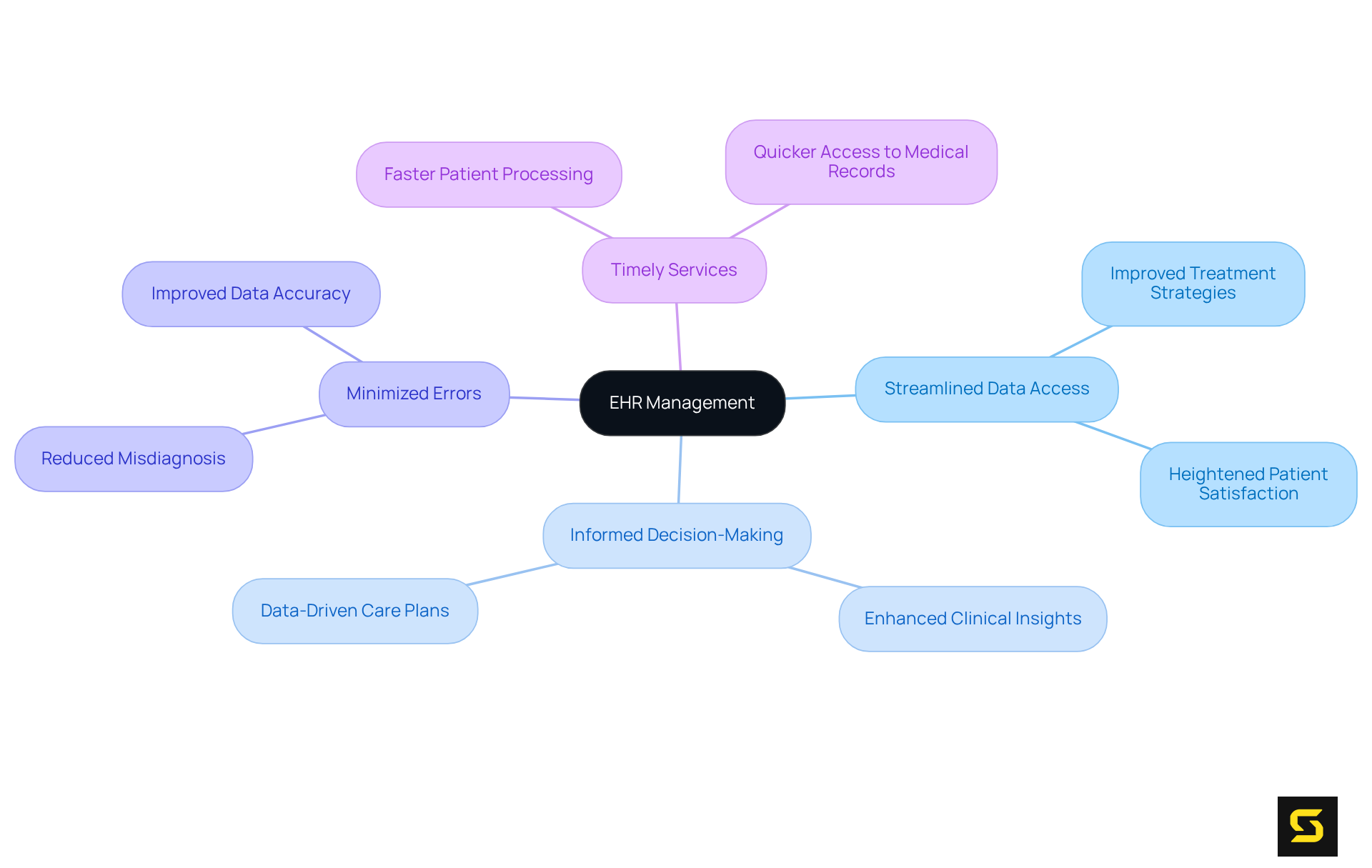
Patient Empowerment: Active Health Monitoring Through Mobile Apps
Mobile software empowers individuals to take charge of their health, actively monitoring vital signs and managing medications with ease. By offering resources that promote self-management, these platforms foster a sense of ownership and accountability in users regarding their health. Notably, 93% of physicians recognize that mHealth apps can enhance health outcomes, underscoring the growing acknowledgment of their significance in healthcare.
Moreover, with 80% of individuals preferring digital communication over traditional methods, the demand for comprehensive health tracking applications is set to rise. SaaS owners have a unique opportunity to capitalize on this trend by creating intuitive mobile solutions that not only boost patient engagement but also enhance adherence to treatment plans. The global mobile health market is projected to expand at an impressive annual rate of 33.5%, presenting substantial opportunities for innovation and leadership in health monitoring apps.
Investing in user-friendly health monitoring applications is further justified by the staggering savings digital solutions have generated in the medical field, estimated between $140 to $240 billion. This reality makes it imperative for SaaS providers to prioritize healthcare application development for such applications. The time to act is now—embrace the future of health management and lead the charge in transforming patient care.
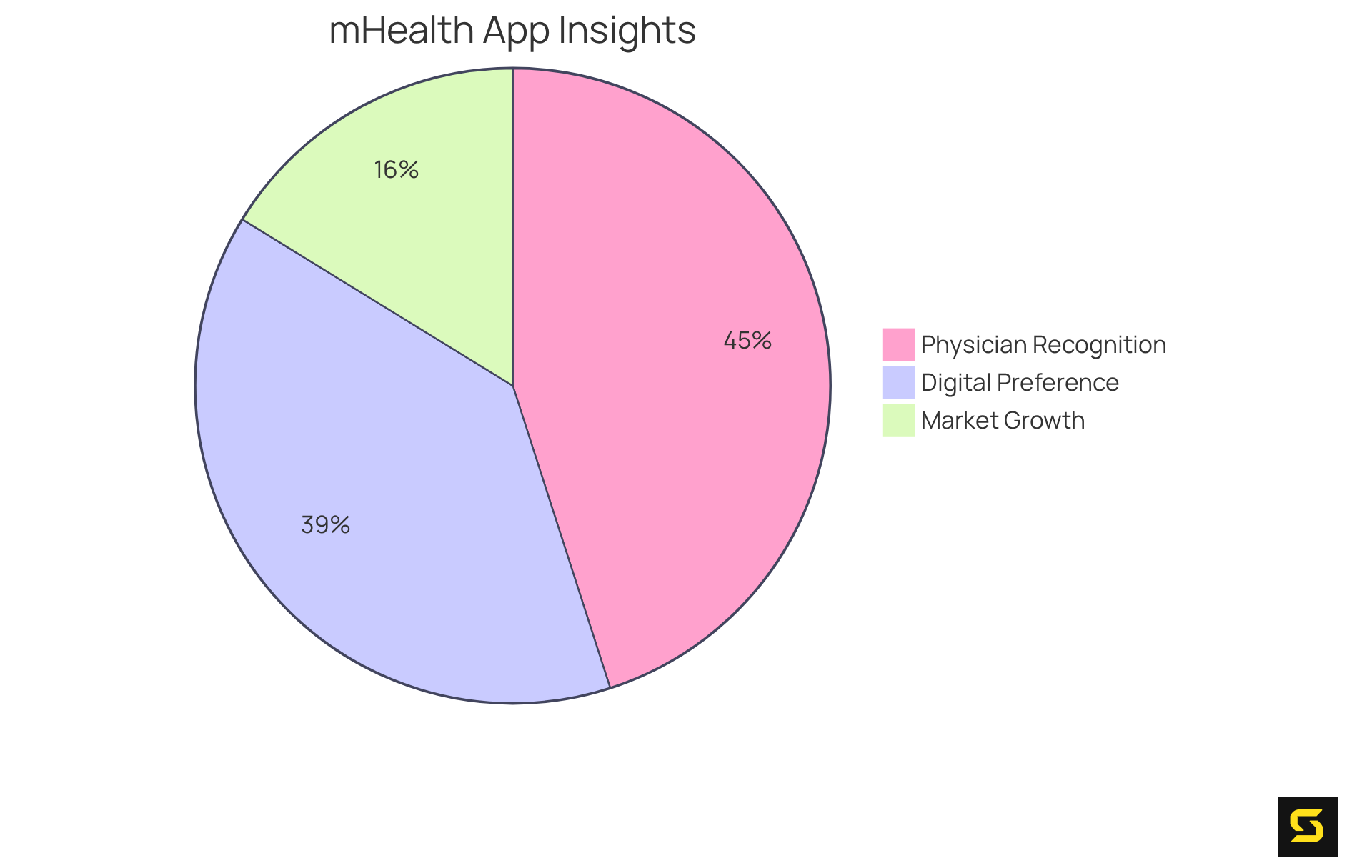
E-Prescribing: Enhanced Medication Management and Safety
E-prescribing systems empower healthcare providers to transmit prescriptions directly to pharmacies electronically, significantly reducing the risks associated with handwritten prescriptions. This advancement not only enhances medication management but also ensures that individuals receive the correct medications promptly. The transition to electronic prescriptions has led to a remarkable increase in prescription changes, with the average number per individual rising from 0.074 to 0.190. This represents a 156% improvement in accuracy and responsiveness in medication management.
SaaS proprietors can leverage e-prescribing features within their platforms to enhance client safety and streamline interactions with pharmacies. The integration of these systems has been shown to decrease overall prescribing mistakes by nearly 50%, as evidenced by various successful projects in medical settings. For example, a study conducted in a tertiary military hospital revealed a significant reduction in prescribing errors, dropping from 1.43% to 0.51% after implementing e-prescribing modifications.
Pharmacists have reported substantial improvements in their workflow, particularly in clarifying medication orders and prioritizing tasks, following the adoption of electronic prescription systems. As one pharmacist noted, "The implementation of these systems has positively impacted pharmacy performance in terms of speed, accuracy, and ease of operations." By embracing e-prescribing technology, SaaS solutions can not only enhance operational efficiency but also contribute to creating a safer medical environment for patients.
In conclusion, the adoption of e-prescribing systems is not just a technological upgrade; it is a vital step toward improving healthcare application development and enhancing patient safety. Embrace this innovation to ensure your practice remains at the forefront of effective medication management.
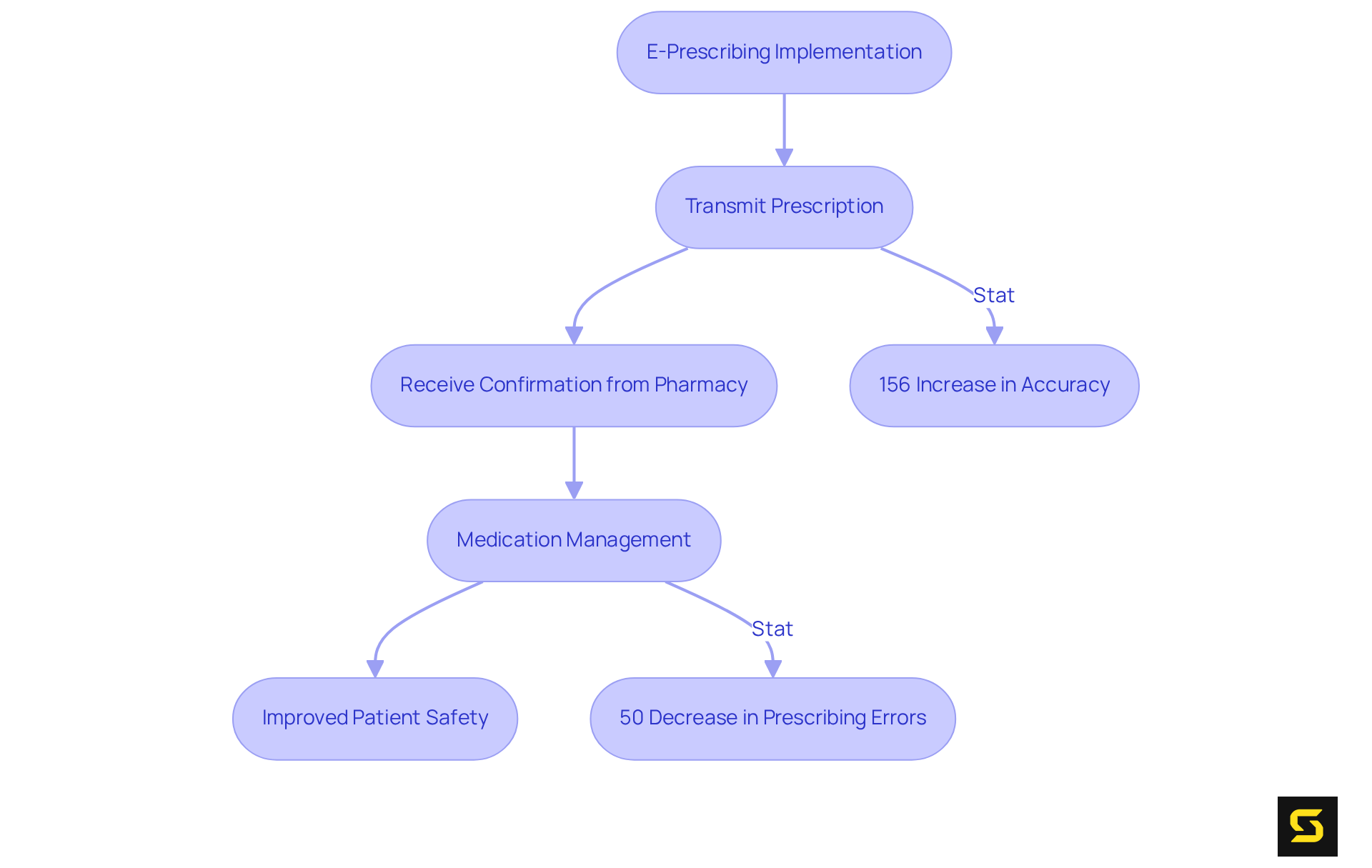
Cost Reduction: Optimizing Resources and Improving Service Delivery
Healthcare application development is pivotal in slashing operational costs by optimizing resource allocation and enhancing service delivery. By automating routine tasks and streamlining workflows, medical providers can concentrate on delivering high-quality care while simultaneously cutting expenses. For instance, predictive analytics can identify high-risk individuals early, enabling prompt interventions that significantly reduce avoidable hospital readmissions and emergency visits, ultimately conserving costs for medical organizations. Furthermore, robotic process automation (RPA) can handle billing and appointment scheduling, freeing up staff time and minimizing errors—an essential factor in a sector grappling with increasing client volumes and staff shortages.
Healthcare administrators are acutely aware of the transformative potential of technology in resource optimization. As one expert stated, "Digital automation is revolutionizing the medical field by refining administrative, clinical, and operational workflows through AI, ML, RPA, and EHR systems." This perspective resonates widely within the industry, with over 70% of C-suite executives prioritizing operational efficiencies and productivity gains this year.
SaaS providers must leverage these insights when developing solutions for the medical sector. The integration of advanced technologies not only enhances care but also leads to significant cost reductions. By focusing on healthcare application development, automation, and resource optimization, medical solutions can achieve improved operational efficiency and superior outcomes for patients, making them indispensable in today’s healthcare landscape.
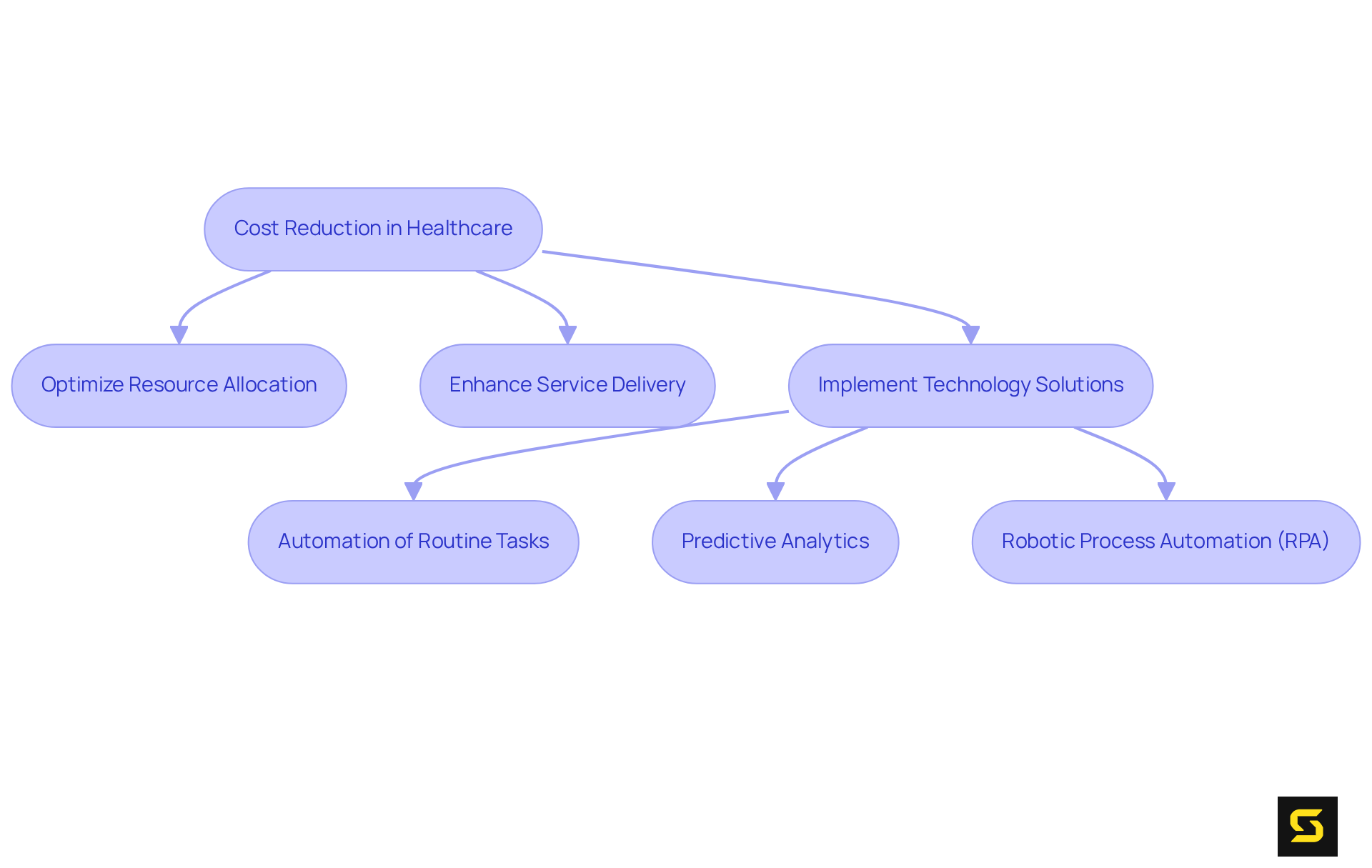
Telemedicine Support: Increasing Access to Care for Underserved Patients
Telemedicine support empowers medical professionals to connect with marginalized individuals who struggle to access traditional medical services. By facilitating virtual consultations and remote monitoring, telemedicine applications effectively break down barriers to care, ensuring that all patients receive the attention they need. In 2023, telemedicine accounted for 4% of outpatient consultations, a significant increase from pre-pandemic levels, underscoring its growing importance in healthcare delivery. Notably, telemedicine utilization surged from less than 0.05% of outpatient consultations in 2019 to 25% in April 2020, illustrating the dramatic transformation in medical delivery during the pandemic.
SaaS providers have a unique opportunity for healthcare application development to create solutions that enhance telemedicine capabilities, promoting equitable access to healthcare services. Community outreach initiatives are crucial for onboarding older adults to telemedicine, addressing existing disparities in access. As health advocates emphasize, addressing these disparities is essential for improving health outcomes and fostering a more inclusive healthcare system.
Effective telehealth solutions not only boost user engagement but also contribute to healthcare application development that streamlines healthcare delivery. Therefore, it is vital for SaaS developers to focus on healthcare application development by creating intuitive platforms that cater to diverse user needs. Additionally, we must acknowledge the challenges faced by individuals experiencing homelessness, particularly regarding privacy concerns and access to telemedicine. This reinforces the urgent need for equitable solutions that ensure everyone can benefit from telehealth services.

Enhanced Patient Compliance: Reminders and Follow-Ups for Better Adherence
Healthcare tools significantly enhance individual adherence by sending timely notifications for medication intake, appointments, and follow-ups. These essential features empower individuals to stick to their treatment plans, leading to improved health outcomes.
SaaS proprietors must recognize the value of incorporating compliance tools into their software. By doing so, they not only enhance adherence but also elevate the overall quality of service they provide.
Imagine a platform where users receive reminders tailored to their specific needs, ensuring they never miss a dose or appointment. This proactive approach not only fosters trust but also demonstrates a commitment to patient care.
Incorporating these tools is not just an option; it’s a necessity for those engaged in healthcare application development to remain competitive in the healthcare landscape. Take action now to integrate compliance features into your offerings and witness the transformative impact on user engagement and satisfaction.
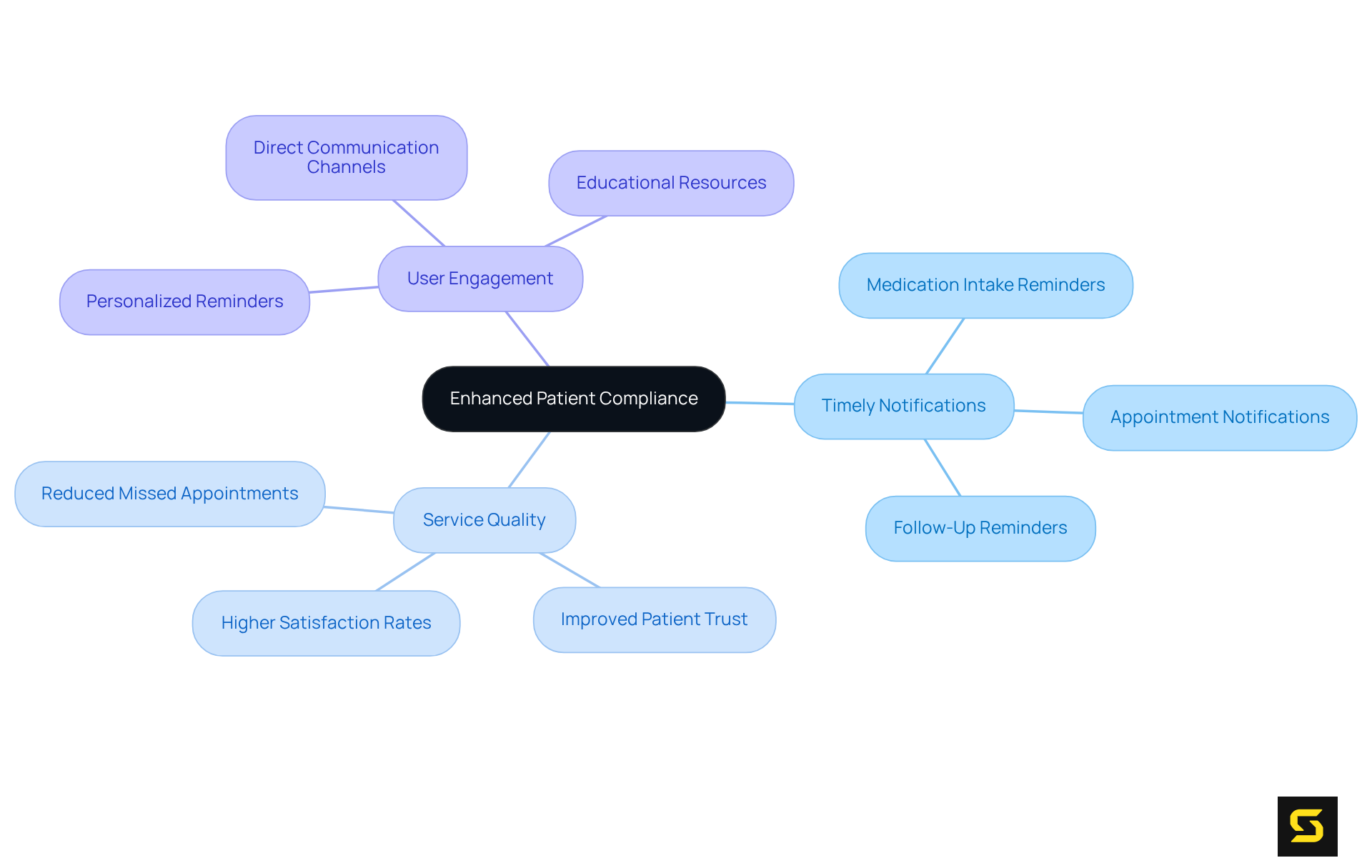
Data-Driven Insights: Leveraging Analytics for Improved Patient Care
Healthcare tools that leverage data analysis provide critical insights into individual treatment trends and outcomes. By examining this data, medical providers can pinpoint areas needing improvement and make informed decisions that significantly enhance the quality of patient care. Imagine the impact: when SaaS owners integrate robust analytics capabilities into their healthcare application development, they empower healthcare providers with the essential information required to drive better outcomes.
This approach not only fosters a deeper understanding of patient needs but also positions healthcare professionals to act decisively. With the right data at their fingertips, they can tailor treatments and interventions that resonate with individual patient profiles. The result? A healthcare landscape that prioritizes personalized care and improved results.
Now is the time for SaaS owners to take action. By focusing on healthcare application development and implementing these analytics capabilities, they can transform the way healthcare is delivered, ensuring that providers have the tools they need to succeed. Don't miss the opportunity to be at the forefront of this vital change.

Conclusion
The development of healthcare applications presents significant advantages for SaaS owners, fundamentally reshaping the delivery and experience of medical services. By adopting innovative software solutions, stakeholders can enhance patient care, streamline operations, and ultimately achieve better health outcomes. This transformation not only improves communication and data management but also empowers patients to actively engage in their health journeys.
Key advantages highlighted throughout this discussion include:
- The rise of telehealth applications
- Improved EHR management
- The critical role of patient compliance tools
Telehealth solutions offer convenient access to care, while electronic health records facilitate better decision-making through streamlined data access. Moreover, mobile health apps promote proactive health monitoring, and e-prescribing enhances medication management and safety. Each of these components contributes to a more efficient, patient-centered healthcare system.
As the healthcare landscape evolves, the necessity of integrating advanced technologies into SaaS offerings becomes increasingly clear. By prioritizing healthcare application development, SaaS providers not only enhance their service delivery but also position themselves at the forefront of a vital transformation in healthcare. The call to action is unmistakable: seize the opportunity to innovate and lead the charge in improving healthcare accessibility, quality, and efficiency for all.
Frequently Asked Questions
What is SDA and what role does it play in custom software development for healthcare?
SDA is a leader in bespoke software solutions that enhances patient care through advanced technologies tailored for the medical field. They focus on user-centered design and robust functionality, ensuring that medical software meets regulatory standards and improves user experience.
How does SDA contribute to healthcare application development?
SDA creates healthcare applications that seamlessly integrate into healthcare practices, improving outcomes and elevating patient experiences. Their solutions ensure compliance and prioritize user engagement, making them a strategic partner for SaaS owners in the medical sector.
What are telehealth applications and their benefits?
Telehealth applications allow individuals to consult with medical professionals remotely, reducing the need for in-person visits. Benefits include heightened patient satisfaction, improved access for underserved populations, and the ability for providers to manage a larger patient load effectively.
What is the expected trend for telehealth services in the U.S. by 2025?
By 2025, approximately 80% of people in the U.S. are expected to have accessed telehealth services at least once, indicating a significant shift towards virtual healthcare.
How does healthcare application development improve communication between patients and providers?
Healthcare application development enhances communication through features like secure messaging and appointment reminders, allowing for real-time updates and feedback. This improves coordination and ensures timely health information delivery.
Can you provide an example of effective communication in healthcare?
Northwell Health's text-based chat service is an example, as it monitors high-risk groups and provides regular health insights, leading to positive feedback and reduced hospital readmissions.
Why is secure messaging important in healthcare communication?
Secure messaging facilitates prompt responses to inquiries and concerns, enhancing user satisfaction. Transparency about the use of individual information is crucial for building trust, leading to improved outcomes for individuals.
What is the significance of healthcare application development for SaaS providers?
Healthcare application development is vital for SaaS providers as it allows them to create programs that meet regulatory standards while enhancing the overall user experience, ultimately leading to better patient care.





